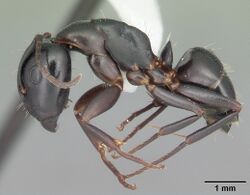Biology:Camponotus nearcticus
| Camponotus nearcticus | |
|---|---|

| |
| Scientific classification | |
| Domain: | Eukaryota |
| Kingdom: | Animalia |
| Phylum: | Arthropoda |
| Class: | Insecta |
| Order: | Hymenoptera |
| Family: | Formicidae |
| Subfamily: | Formicinae |
| Genus: | Camponotus |
| Species: | C. nearcticus
|
| Binomial name | |
| Camponotus nearcticus Emery, 1893
| |
| Synonyms | |
| |
Camponotus nearcticus, commonly named smaller carpenter ant, is a relatively small carpenter ant. Its appearance is similar to Lasius niger, commonly named the black garden ant. The ant is a household pest.
Identification
Workers can range from 3.5 to 7.5 mm (0.14 to 0.30 in) in length.[1] The queen ant's size can range from 4 to 10 millimetres (0.16 to 0.39 in).[2] This species can be distinguished from other subgenus by little amounts of erect hairs on the gena, limited erect hairs on the clypeal disc and finally by the color which is a concolorous dark brown-black.[1]
Distribution and habitat
Camponotus nearcticus colonies can be found in the United States and in Canada . They can be found in Ontario, and extend south from North Dakota to Colorado and Florida.[3]
Prairies and woodlands are preferred habitats for Camponotus nearcticus ants. This ranges from deciduous forests, oaks and other pine forests.[4] Colonies can be found in dead twigs, branches, logs, bark from trees in various conditions, pine cones and in wooden regions in buildings, usually around rooftops. Nests are small, consisting of only a few hundred individuals.[3] However, a large nest which was studied on consisted of 531 individuals, not including the nests brood, and also reproductives were usually seen in nests from March to October.[4] The ant is considered a household pest.[3]
References
- ↑ 1.0 1.1 MacGown, Joe (6 March 2003). "Camponotus (Myrmentoma) nearcticus Emery". Mississippi Entomological Museum (Mississippi State University). http://mississippientomologicalmuseum.org.msstate.edu/Researchtaxapages/Formicidaepages/genericpages/Camponotus_nearcticus.htm#.VKPm2iuUdvo. Retrieved 31 December 2014.
- ↑ Emery, Carlo (1893). "Beiträge zur Kenntnis der nordamerikanischen Ameisenfauna". Zoologische Jahrbücher Abteilung für Systematik Ökologie und Geographie der Tiere 7: 633–682. http://antcat.org/references?q=124571. Retrieved 31 December 2014.
- ↑ 3.0 3.1 3.2 Smith, Marion R. (1965). "House-infesting ants of the eastern United States : their recognition, biology, and economic importance". Technical Bulletin No. 1326. (Washington, D.C.: United States Department of Agriculture): 72. OCLC 6078460. https://archive.org/stream/ants_10395/ants_10395_djvu.txt. Retrieved 31 December 2014.
- ↑ 4.0 4.1 Mackay, William; Mackay, Emma (2002). The ants of New Mexico: (Hymenoptera: Formicidae). Lewiston, N.Y.: Edwin Mellen Press. ISBN 978-0773468849.
External links
- Camponotus nearcticus entry at AntWeb
Wikidata ☰ Q1315276 entry
 |
